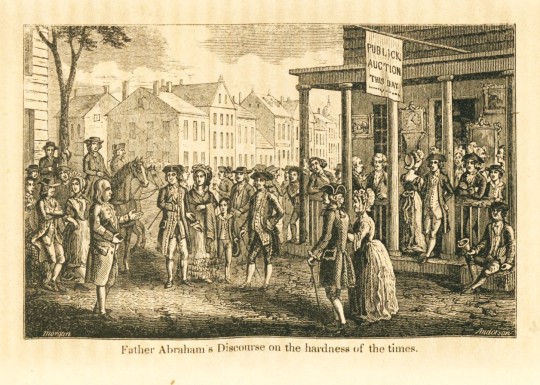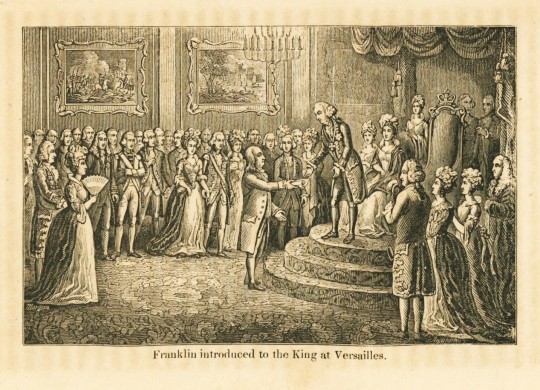#Tompkins Harrison Matteson
Text










Wood Engraving Wednesday
ALEXANDER ANDERSON
Thomas Bewick (1753-1828) is well-known for popularizing the wood engraving for book illustration in Great Britain and Alexander Anderson (1775-1870) is his American counterpart as one of the earliest of American wood engravers. He trained and worked as a physician and was self-taught as an engraver. By 1820 he committed himself entirely to illustrating books with wood engravings.
Shown here are wood engravings from the 1848 biography The Life of Benjamin Franklin by O. L. Holley, published in New York by educational book publisher George F. Cooledge & Brother. The engraved title page was engraved by Anderson from an illustration by American artist Tompkins Harrison Matteson (1813-1884). The remainder of the illustrations in the book were engraved by Anderson from illustrations by Anderson's student and frequent collaborator William Penn Morgan (active 1811-1872).
View another post with illustrations by Alexander Anderson.
View more posts with wood engravings!
#Wood Engraving Wednesday#wood engravings#wood engravers#Alexander Anderson#The Life of Benjamin Franklin#George F. Cooledge & Brother#O. L. Holley#Tompkins Harrison Matteson#T. H. Matteson#William Penn Morgan#biographies#children's books
26 notes
·
View notes
Text




Tompkins Harrison Matteson, “The Trial of George Jacobs, 5th August 1692” , 1855, Oil on Canvas.
#art#america#usa#fine arts#oil painting#art academia#my edit#american painter#academism#dark academia#witch trials
2 notes
·
View notes
Text

*A very good reason to have that whole Separation of Church and State… You know we tried it the religious way… and people started getting hung and burned alive. So yeah, keep that religion in the church and/or temple and out of government…
Today in History:
Mar. 1, 1692 – Sarah Good, Sarah Osborne and Tituba are brought before local magistrates in Salem Village, Massachusetts, beginning what would become known as the Salem witch trials.
(https://en.wikipedia.org/wiki/Salem_witch_trials)
*Painting:
‘Trial of George Jacobs of Salem for witchcraft’
by Matteson, Tompkins Harrison, 1813-1884
0 notes
Text

The Trial of George Jacobs, Sr. for Witchcraft.
By Tompkins Harrison Matteson, 1855. Oil on canvas. Gift of R. W. Ropes, 1859. 1246.
Found at the Peabody Essex Museum.
1 note
·
View note
Text
LoveSpell: Against Endings
by Erica Jong
All the endings in my life
rise up against me
like that sea of troubles
Shakespeare mixed
with metaphors;
like Vikings in their boats
singing Wagner,
like witches
burning at
the stake--
I submit
to my fate.
I know beginnings,
their sweetnesses,
and endings,
their bitternesses--
but I do not know
continuance--
I do not know
the sweet demi-boredom
of life as it lingers,
of man and wife
regarding each other
across a table of shared witnesses,
of the hand-in-hand dreams
of those who have slept
a half-century together
in a bed so used and familiar
it is rutted
with love.
I would know that
before this life closes,
a soulmate to share my roses--
I would make a spell
with long grey beard hairs
and powdered rosemary and rue,
with the jacket of a tux
for a tall man
with broad shoulders,
who loves to dance;
with one blue contact lens
for his bluest eyes;
with honey in a jar
for his love of me;
with salt in a dish
for his love of sex and skin;
with crushed rose petals
for our bed;
with tubes of cerulean blue
and vermilion and rose madder
for his artist's eye;
with a dented Land-Rover fender
for his love of travel;
with a poem by Blake
for his love of innocence
revealed by experience;
with soft rain
and a bare head;
with hand-in-hand dreams on Mondays
and the land of fuck
on Sundays;
with mangoes, papayas
and limes,
and a house towering
above the sea.
Muse, I surrender
to thee.
Thy will be done,
not mine.
If this love spell
pleases you,
send me this lover,
this husband,
this dancing partner
for my empty bed
and let him fill me
from now
until I die.
I offer my bones,
my poems,
my luck with roses,
and the secret garden
I have found
walled in my center,
and the sunflower
who raises her head
despite her heavy seeds.
I am ready now, Muse,
to serve you faithfully
even with
a graceful dancing partner--
for I have learned
to stand alone.
Give me your blessing.
Let the next
epithalamion I write
be my own.
And let it last
more than the years
of my life--
and without the least
strain--
two lovers bareheaded
in a summer rain.
Tompkins Harrison Matteson 1853 Examination of a Witch, oil on canvas, Peabody Essex Museum, Salem, Massachusetts, USA

#Tompkins Harrison Matteson#Examination of a Witch#Matteson#LoveSpell: Against Endings#Jong#Erica Jong#Art#Poetry#Fine Arts#Poems#Paintings
10 notes
·
View notes
Photo

Lafayette in Prison at Olmütz, 1795-97 - Tompkins Harrison Matteson, 1850
#marquis de lafayette#my dear marquis#art#tompkins harrison matteson#19th-century#1850s#olmutz#adrienne de lafayette#adrienne de noailles
105 notes
·
View notes
Photo

“The Last of the Race”, 1946, Tompkins Harrison Matteson (1813-1884), New York Historical Society, New York
This painting was perhaps done as a counterpoint to the colonial and racist arrogance of “Manifest Destiny”, the inexorable expansion of white, Christian America to the West Coast, invading and eventually defeating Native Americans (and Mexicans) along the way. The term, “manifest destiny”, was coined in 1845, only a year before this painting, denoting the presumed God-given right (and duty) of Americans to seize the continent.
Matteson’s title betrays a common settler chauvinism, the presumption that the native race would simply disappear. It has also been suggested that this type of picture, that of a “doomed Indian”, helped to assuage collective guilt by somehow suggesting their demise as inevitable.
Nevertheless, this painting recognised that the land wasn’t bequeathed to Americans by some deity but was stolen from others. This family has an air of dignity, though a defeated and perhaps cliched dignity given they have been driven to the edge of the continent. At least Matteson recognised dignity at a time when most Americans saw a presumed lack of civilisation. And the painting acknowledges the human cost of Manifest Destiny at a time when most Americans received the idea euphorically and without question.
#indigenous#Tompkins Harrison Matteson#Native Americans#Manifest Destiny#colonialism#racism#genocide#American Indians#land
11 notes
·
View notes
Photo

Tompkins Harrison Matteson: Examination of a Witch (detail), 1853
One of the worst mass hysteria events in American history, the Salem Witch Trials. Reckoning With—and Reclaiming—the Salem Witch Trials. A 2021 exhibition, smithsonianmag the-salem-witch-trials-history-art-colonial-witchcraft
The infamous Salem Witch Trials began during the spring of 1692, after a group of young girls in Salem Village, Massachusetts, claimed to be possessed by the devil and accused several local women of witchcraft. A special court convened in Salem to hear the cases convicted, Bridget Bishop, hanged that June. Eighteen others followed Bishop to Salem’s Gallows Hill, while some 150 more men, women and children were accused over the next several months. - https://www.history.com/topics/colonial-america/salem-witch-trials
According to Silvia Federici, witch-hunting is not only alive and well but enjoying a resurgence and it has everything to do with capitalism, and always has. -.randomlengthsnews 2022/03/18/witches-women
The six essays that comprise Witches, Witch-Hunting, and Women are breezy enough (academically, at least) to fit the bill, while at the same time expanding her scope to indict neoliberalism as a fomenter of modern-day witch hunts.
Federici points to pre-Reformation England and the creation of enclosures, “whereby landlords and well-to-do peasants fenced off the common lands, putting an end to customary rights and evicting the population of farmers and squatters that depended on them for survival,” as an earliest example of these capitalist relations. “In all its forms this was a violent process, causing a profound polarization in what had previously been communities structured by reciprocal bonds.”
In 2004’s Caliban and the Witch: Women, the Body and Primitive Accumulation (PDF), Federici plumbs the depths of witch-hunting as a response to resistance against nascent capitalism. - Book Review — Witches, Witch-Hunting, and Women, 2022
#Salem Witch Trials#witch-hunting#History#mass hysteria#capitalism#Silvia Federici#book#politics#witchcraft#USA#justice#neoliberalism
28 notes
·
View notes
Text

Tompkins Harrison Matteson (1813 - 1884)
James Fenimore Cooper (1789 - 1851)
THE TURKEY SHOOT 1857
Fenimore Art Museum
6 notes
·
View notes
Photo

Scene from Literature (from McGuire Scapbook), Tompkins Harrison Matteson, American Paintings and Sculpture
Gift of James C. McGuire, 1926
Size: 5 3/8 x 4 15/16 in. (13.7 x 12.5 cm)
Medium: Graphite on off-white wove paper
https://www.metmuseum.org/art/collection/search/11522
1 note
·
View note
Photo

A Witch’s Mark or a Devil’s mark was the imprint of the Devil’s initials on a witch using his claws or a hot iron. During witch trials in the 1600s, the practice of “pricking a witch” came about where witches had pins driven into old scars or calluses to find an area free of pain that proved a communion with the devil.
Painting - "Examination of a witch" by Tompkins Harrison Matteson (1853)
#tompkinsharrisonmatteson#witchmark#witchesmark#devilsmark#witchtrials#prickingawitch#witchhistory#witch#witches#witchy#witchyvibes#witchesoftumblr#witchgame#covensgame#covenstheemberdays#covenstournamentofwitchcraft#covens#raincrow studios#raincrowgames#realworldgames#mobilegames#indiestudios#indiegames#innerwitch#witchon
22 notes
·
View notes
Text
Caza de brujas: cómo la paranoia colectiva dejó 40.000 muertes en la Europa de las hogueras
En enero, el Parlament decidió reivindicar a las mujeres ejecutadas por brujería en los albores de la modernidad, cuando el Viejo Continente sucumbió a la creencia en una conjura satánica. ¿Cómo pudo suceder? Interpretaciones feministas, sociológicas, religiosas y antropológicas tratan de entender aquel frenesí de persecuciones.
Examen de una bruja. Tompkins Harrison Matteson, 1853. / Wikimedia…

View On WordPress
0 notes
Photo

Lafayette in Prison at Olmütz, 1795-97 by Tompkins Harrison Matteson (1850)
Lafayette College Art Collection
Both Gilbert and Adrienne are looking in rather better shape here than they were for most of their imprisonment (Lafayette is even sporting some rather stylish clothes, even if he’s cravatless, and has a lot more hair).
#Gilbert du Motier Marquis de Lafayette#marquis de lafayette#adrienne de lafayette#marquise de lafayette#anastasie de lafayette#virginie du motier#anastasie du motier
46 notes
·
View notes
Photo

*A very good reason to have that whole Separation of Church and State… You know we tried it the religious way... and people started getting hung and burned alive. So yeah, keep that religion in the church and/or temple and out of government...
Today in History:
Mar. 1, 1692 – Sarah Good, Sarah Osborne and Tituba are brought before local magistrates in Salem Village, Massachusetts, beginning what would become known as the Salem witch trials.
(https://en.wikipedia.org/wiki/Salem_witch_trials)
*Painting:
'Trial of George Jacobs of Salem for witchcraft'
by Matteson, Tompkins Harrison, 1813-1884
0 notes
Text
Now you will feel no rain
A traditional Apache song
Now you will feel no rain,
for each of you will be a shelter to the other.
Now you will feel no cold,
for each of you will be warmth to the other.
Now there is no loneliness for you;
now there is no loneliness.
Now you are two bodies,
but there is only one life before you.
Go now to your dwelling place,
to enter into your days together.
And may your days be good
and long on this earth.
Tompkins Harrison Matteson 1847 The Last of the Race, oil on canvas, Collection of the New-York Historical Society, USA

#Tompkins Harrison Matteson#Matteson#The Last of the Race#Apache#Now you will feel no rain#Native Americans#Poetry#Art#Poems#Love Songs#Love Poems#Fine Arts
29 notes
·
View notes
